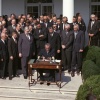Since the collapse of the Soviet empire, legion has been the number of studies and theories seeking to explain how and why its end came about as it did. However, few are as convincing as that put forth by Barbara von der Heydt in her new book, Candles behind the Wall: Heroes of the Peaceful Revolution That Shattered Communism. Von der Heydt’s thesis can be summed up in a phrase: communism failed because it was unable to make people forget about God.
To explain why the Iron Curtain came crashing down, most commentators have sought to focus their gaze through the conventional lens of economics and politics. In doing so, however, they have overlooked the fact that the political and economic crises paralyzing Eastern European communism by the late 1980s were the direct consequence of a prior moral and spiritual crisis, a crisis brought about by Marx’s opposition of faith in man to faith in God.
At its base, communism represented a new anthropology which proceeds from the assumption that God is imaginary, a function created by men who, as an opiate for their misery, project the picture of a benevolent God on the screen of their fantasy and then place their hope in this picture. This picture, asserted communism, had to be destroyed so that all man’s efforts might be directed to building a new world, and not squandered in the adoration of God. In the Marxist world view, man no longer needed to cling to any dreams of a happy hereafter if the “worker’s paradise” could be built on earth.
However, if the new socialist man was to dedicate himself completely to the task of building paradise on earth, it was necessary that every form of faith in God, even the most private, be overcome. Hence, religion could not be tolerated, even as a private affair since even the most private faith in God had public implications, insofar as it impaired a man’s energies in fashioning a new world in the here and now. Thus, the struggle against religious faith was a central concern to the erstwhile rulers of Eastern Europe.
In this context, it is easier to comprehend von der Heydt’s assertion that: “The reason that Communism collapsed is that Marxism is based on the false premise that the nature of man is inherently good and perfectible through human endeavor, that it is a product of his material surroundings, devoid of transcendence.” But as von der Heydt herself observes, faith without transcendence produces tyranny.
Against the backdrop of this tyranny is found the common thread which runs from the Polish Catholic workers kneeling before the Black Madonna in the Gdansk shipyard to the East German Protestant students gathered on the rooftops of the churches in Potsdam to the Russian Orthodox grandmothers who faced down tanks in Moscow armed only with icons. These people all experienced a revolution of the spirit, a basic rejection of communism at the moral level which eventually grew into a mass movement with political consequences. It was what Polish theologian Józef Tichner aptly described as a “forest of awakened consciences”: when individual believers with a heightened sense of the need to live in integrity began to stand up for what they believed in, they challenged communist totalitarianism at its very roots.
Von der Heydt, who worked with the first wave of Eastern European refugees in 1989, retraced their steps in the wake of that year’s revolution. Based on numerous interviews, she has written a portrait of some of the lesser-known figures of resistance, including, among others, Alexander Ogorodnikov, Vaclav Maly, and Fathers Alexander Vorisov and Alexander Men. While each of their stories is unique certain elements are common to all of them: their “conversion” experiences when they first realized that they cannot responsibly collaborate with the regime, the price they each pay for their resistance, and, most poignantly, their unbowed Christian dignity through it all, a dignity and faith which only grew in the face of the hatred before them.
Perhaps the most memorable of von der Heydt’s stories is the account of East German Pastor Uwe Holmer and his wife, who led a Christian community for the mentally handicapped, aged, and epileptics near East Berlin. For their pastoral activities, the Holmers had suffered terribly during the long reign of dictator Erich Honecker. In late 1989, Honecker left office as perhaps one of the most hated men alive: no one would take the ailing despot in, not even his own daughter. Finally, the Holmers gave shelter to Honecker and his wife, deposed Education Minister Margot Honecker. Pastor Holmer’s explanation for his seemingly irrational behavior in taking in the very couple who caused him and eight of his ten children untold suffering was simple enough:
The Lord has charged us to follow him and to take in all those who are troubled or burdened ... to follow his commandment to love our enemies; and to live by the prayer he taught us in these words, “forgive us our trespasses as we forgive those who trespass against us.” ... We want to live by Christ’s example.
In this dramatic manner, von der Heydt succeeds in both recounting the experiences of ordinary, yet heroic, individuals while simultaneously offering an overview of the factors that led to the toppling of communism, making the latter of interest to a broad range of readers, many of whom would perhaps shy away from a more scholarly account with the same thesis. In fact, this reviewer has only one criticism which would, in itself, only slightly diminish his ovation of von der Heydt’s book. If von der Heydt errs at all, it is perhaps in accepting as prima facie truth the stories of many of the people she has interviewed. For example, the first twenty-five pages of Candles behind the Wall recount the story of one Rüdiger Knechtel, whom von der Heydt portrays as a Christian leader in East Germany who was jailed until 1964. However, in the midst of writing about Herr Knechtel’s interviews of former secret police collaborators, von der Heydt mentions that some of these collaborators had helped in 1982 to confiscate a considerable art and antique collection from the same Herr Knechtel. While this reviewer has no knowledge of Herr Knechtel, he would have thought that von der Heydt would have wanted to know how it was that any persecuted Christian leader in any Eastern European country could have even begun to amass any sort of art and antique collection during the Brezhnev era.
In any event, von der Heydt’s work will serve to remind many in the West that while it may be exporting capitalism and democracy–institutions which, as Michael Novak and others often remind us, rest on a foundation of belief in a transcendent God–to Eastern Europe, it would do well to import from there some of the spiritual depth and moral commitment which alone make that belief worthwhile.












